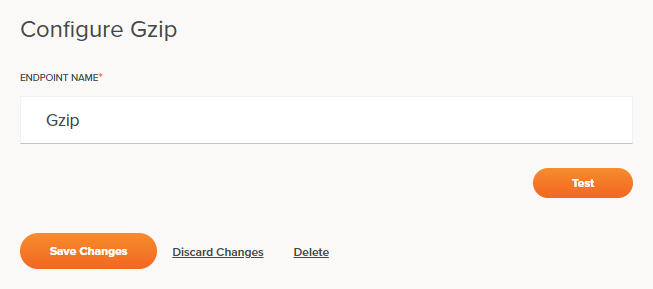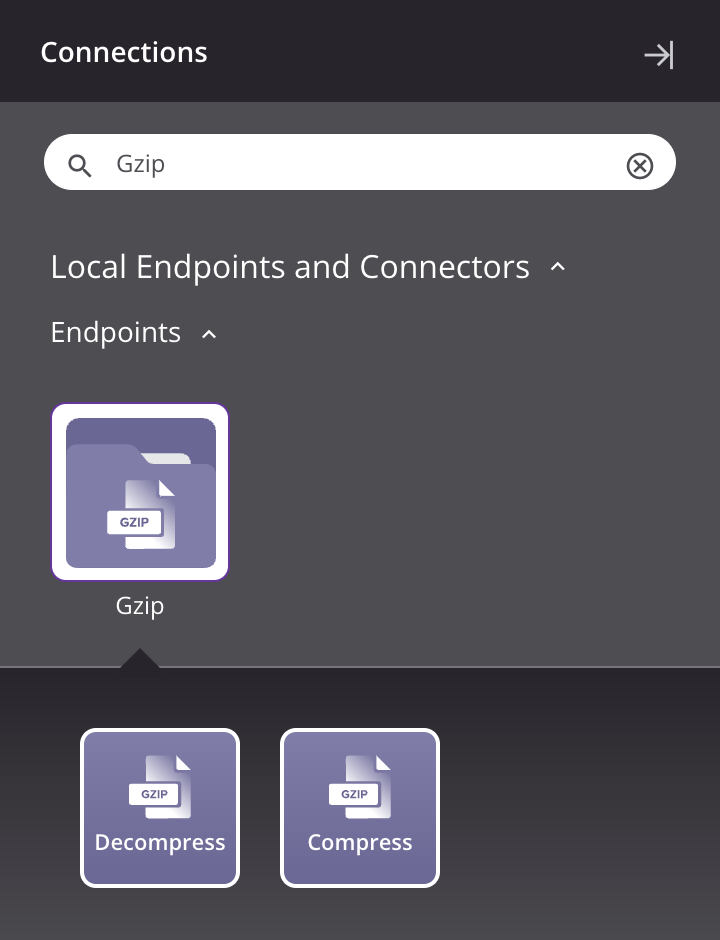Gzip connection¶
Introduction¶
A Gzip connection is configured using the Gzip connector, establishing access to the Gzip endpoint. Once a connection is established, you can configure one or more Gzip activities associated with that connection to be used either as a source to provide data to an operation or as a target to consume data in an operation.
Create or edit a Gzip connection¶
A new Gzip connection is created using the Gzip connector from one of these locations:
- The design component palette's Project endpoints and connectors tab (see Design component palette).
- The Global Connections page (see Create a global connection in Global connections).
An existing Gzip connection can be edited from these locations:
- The design component palette's Project endpoints and connectors tab (see Design component palette).
- The project pane's Components tab (see Component actions menu in Project pane Components tab).
- The Global Connections page (see Edit a global connection in Global connections).
Configure a Gzip connection¶
Configuration of a Gzip connection includes these fields:

Tip
Fields with a variable icon ![]() support using global variables, project variables, and Jitterbit variables. Begin either by typing an open square bracket
support using global variables, project variables, and Jitterbit variables. Begin either by typing an open square bracket [ into the field or by clicking the variable icon to display a list of the existing variables to choose from.
-
Connection Name: Enter a name to use to identify the Gzip connection. The name must be unique for each Gzip connection and must not contain forward slashes (
/) or colons (:). This name is also used to identify the Gzip endpoint, which refers to both a specific connection and its activities. -
Test: This button can be ignored, as testing a Gzip connection is neither necessary nor possible. When clicked, a message indicating Connection Success is always returned. When the connection is tested, the latest version of the connector is downloaded by the agent(s) in the agent group associated with the current environment. This connector supports suspending the download of the latest connector version by using the Disable Auto Connector Update organization policy.
-
Save Changes: Click to save and close the connection configuration.
-
Discard Changes: After making changes to a new or existing configuration, click to close the configuration without saving. A message asks you to confirm that you want to discard changes.
-
Delete: After opening an existing connection configuration, click to permanently delete the connection from the project and close the configuration (see Component dependencies, deletion, and removal). A message asks you to confirm that you want to delete the connection.
Next steps¶
After a Gzip connection has been created, menu actions for that connection are accessible from the project pane's Components tab. See Connection actions menu for details.
After configuring a Gzip connection, you can configure one or more Gzip activities associated with that connection to be used either as a source (to provide data within an operation) or as a target (to consume data within an operation).
Use the Show dropdown to filter on Endpoints, and then click the Gzip connection block to display activities that are available to be used with a Gzip connection:

For more information, see these activities:
-
Decompress: Decompresses a Base64-encoded string of Gzip-compressed data in a Gzip endpoint and is intended to be used as a source in an operation.
-
Compress: Compresses a string of content into a Base64-encoded string of Gzip-compressed data in a Gzip endpoint and is intended to be used as a target in an operation.